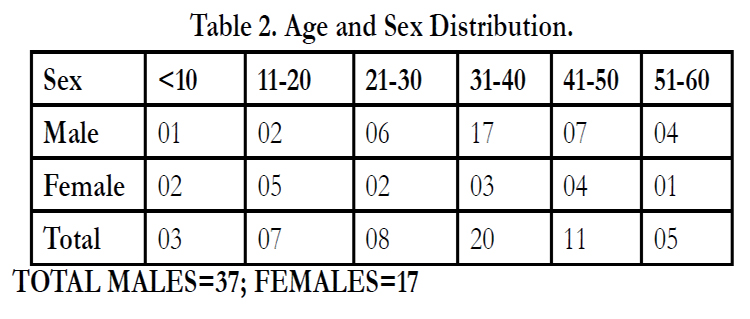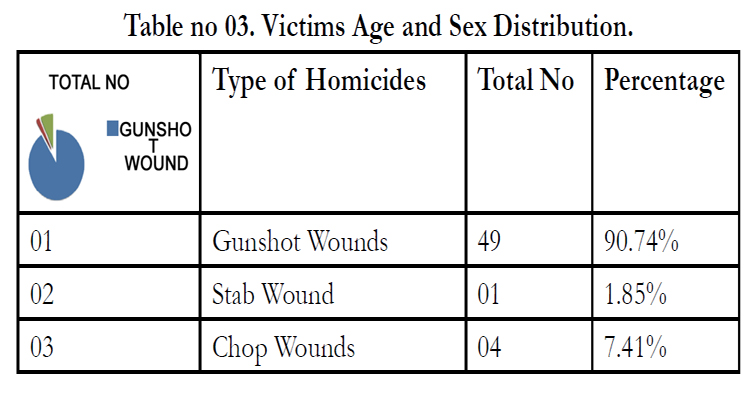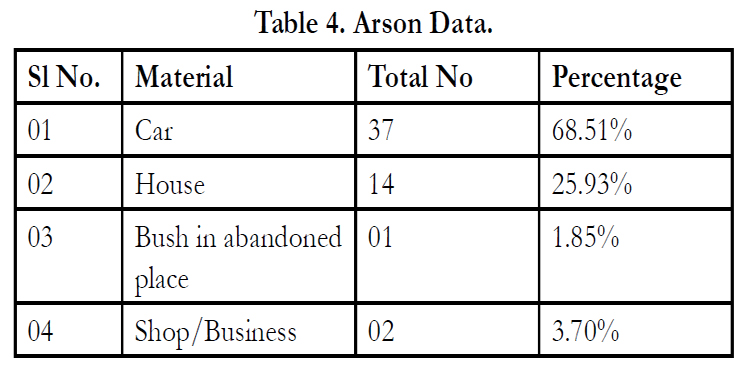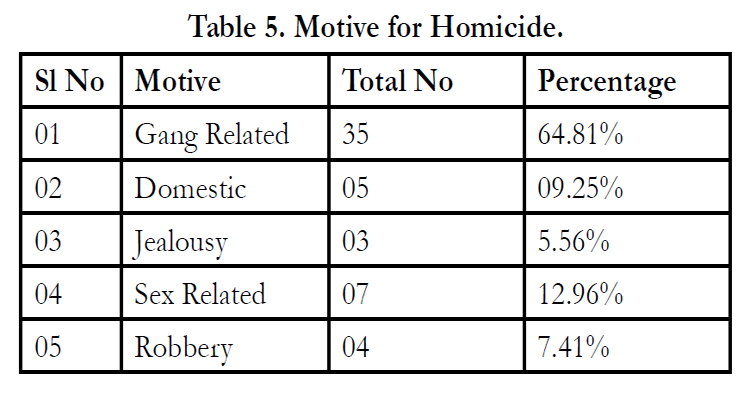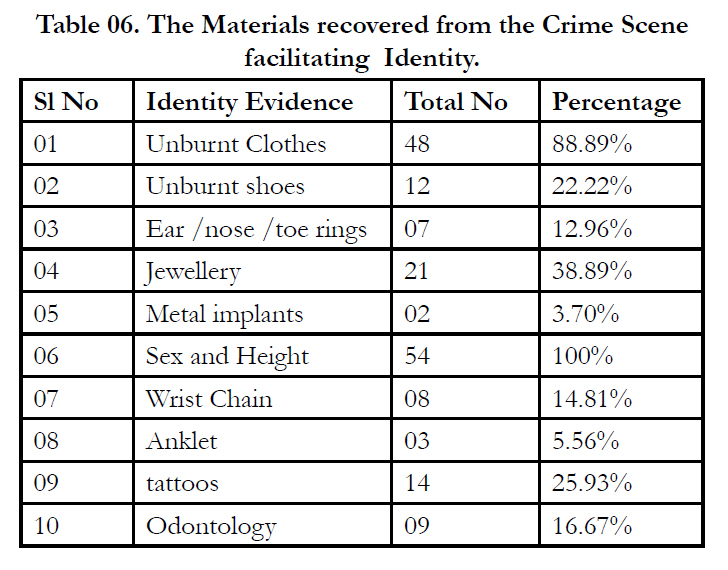An Autopsy Study of Homicide and Arson-54 Cases
Dinesh Rao1,2*
1.Department of Forensic Medicine.SIMS.No 15,Chikkasandra,Hesargatta Main Road,Bangalore-90. India.
2.Ex Director and Chief Forensic Pathologist. Jamaica.
*Corresponding Author
Dinesh Rao,
Department of Forensic Medicine.SIMS.No 15,
Chikkasandra,Hesargatta Main Road,
Bangalore-90. India.
Tel: +919741360206
E-mail:dineshrao22@yahoo.com
Article Type: Research Article
Recieved: March 22, 2014; Accepted: April 22, 2014; Published: May 21, 2014.
Citation: Rao D (2014) An Autopsy Study of Homicide and Arson- 54 Cases. Int J Forensic Sci Pathol. 2(4), 30-33. doi: dx.doi.org/10.19070/2332-287X-1400010
Copyright: Rao D© 2014. This is an open-access article distributed under the terms of the Creative Commons Attribution License, which permits unrestricted use, distribution and reproduction in any medium, provided the original author and source are credited.
Abstract
The present prospective study was carried from 2009 to 2012. During this period a Total of 3907 Homicides were Autopsied, of which 54 cases were recorded due to Murder and Arson Incidents, this contributed to 1.38% of Homicides cases. Majority of the Incidents involved Males contributing to 68.52% (n-37) of cases and the Females contributed to 31.48% ( n-17) of cases. Maximum number of victims belonged to the age group 31-40 (n-20). The least affected Victims were in 1st and the 6th decade. Majority of Murders, 90.74% (n-49), were as a results of Gunshot wounds and the least type of deaths were due to Stab wounds (1.85%; n-01) and Chop wounds (7.41%; n-04). The commonest method adopted for Arson was placing the Victim in the Car and setting Fire, This was reported in 68.51% (n-37) of cases. This was followed by arson on House of the Victim in 25.93% (n-14) of cases. The least type of Method of Arson adopted were placing(Killing) the Victim in Bush in 1.85% (n-01) and Shop(business) in 3.70% (n-02) of cases and setting on Fire. Gang related Murder and Arson contributed to 64.81% (n-35) of cases. The other commonly reported cases were Sex related factors contributing to 12.96% (n-07) of the cases. The least Motivating factor was Jealousy, recorded in only 05.56% (n-03) of cases.
2.Introduction
3.Aims and Objectives
4.Material and Methods
5.Observations
6.Results
7.Discussion
8.Conclusions
9.Acknowledgements
10.References
Keywords
Fire; Gunshot; Chop Wound; Stab Wound; Carbon Monoxide; Crime Scene; Murder; Concealment; Identity.
Introduction
Arson [1] is the crime of intentionally and maliciously setting fire to buildings, wildland areas [2], vehicles [3,4] or other property with the intent to cause damage. More often than not, arsonists use accelerants (such as gasoline or kerosene) to ignite, propel, and directionalize fires. Arson crimes committed to conceal other crime, is sometimes done by criminals who aren't really 'arsonists'. Some criminals commit arson as a backup crime, to hide their main crime, like murder. When arson is committed to conceal another crime, it usually becomes apparent when no other arson crime is committed in the same vicinity (since most arsonists who commit serial arson live nearby the crime sight and keep committing arson). Arson crimes that don't seem to generate a financial payoff to the potential suspect also lend themselves to being more revenge-motivated or committed in order to aid in covering up another crime. The arsonist who commits arson to cover up the crime of murder typically acts alone and under the influence of alcohol or drugs. He is usually single (four out of five) and does not always reside in the vicinity of where the crime occurred [Holmes Holmes.2008] [5].The present prospective study was carried out during the period 2009 to 2012. With a total of 54 cases of Murder wherein Arson was adopted to Conceal the Murder, were studied during this period. It is not unusual for an Arsonist to deliberately set fire to the property of another or to one's own property as to collect insurance compensation [6]. It has been well established, that despite their efforts, the Identity and Crime is well analysed by Meticulous Crime scene examination, Autopsy and Ancillary Investigations. In the present study all those Cases of Homicides wherein Arson was used as a mode to conceal the Crime and the Identity of the Victim were extensively analysed. The materials retrieved from the Crime scene and during Autopsy helped in establishing the Identity of the Victim, and Circumstances surrounding the Death. Further the Autopsy examination confirmed the Causes of Death, other than due to effects of Fire. All this factors helped the Investigators to establish the Motive behind the Crime.
Aims and Objectives
• To study the incidence of homicide and arson cases.
• To study the type of homicides followed by arson.
• To collect evidence materials to identify the victim both at the scene and during autopsy.
• To study the motive behind the murder and arson.
• To study the cause of death in homicides followed by arson.
• The circumstances surrounding the murder and arson cases.
Material and Methods
• All cases referred to legal medicine unit as arson,accidental fire and murder followed by arson during the period of 2009 to 2012.
• Crime scene examination done as per the standard crime scene protocols.
• Autopsy examination as per the standard protocols observed in firearm deaths and homicides.
• The carbon monoxide level estimated in all cases.
• Ct scan done in all cases of gunshot wounds.
• Xray in all cases of firearm deaths.
• Dna examination in all cases.
Observations
TOTAL MALES=37; FEMALES=17
Results
Table no 01. Indicates the total number of Homicides recorded during the period of Study and the Percentage of the Murder Arson Cases reported. A total of 3907 cases of Homicides were Autopsied of which 1.38% (n-54) contributed to Murder Arson cases.
Table no 02. Indicates the Ages and Sex distribution of Victims of Murder and Arson. The Males (n-37;68.52%) were more affected than Females(31.48%; n-17). Maximum number of victims belonged to the age group 31-40 (n-20). The other age groups closely affected are from 5th Decade (n-11), 3rd decade (n-08) and 2nd decade(n-07) in its descending order. The least affected Victims were in 1st and the 6th decade.
Table no 03. Indicates the types of Homicides recorded. Majority of them i.e 90.74% (n-49) were deaths due to Gunshot wounds. The least type of deaths recorded were from Stab wounds (1.85%;n-01) and Chop wounds (7.41%; n-04).
Table no 04. Indicates the Type of material subjected to Arson.Majority of them i.e 68.51% (n-37) were Cars (Sedans, SUV), followed by arson on House in 25.93% (n-14) of cases. The least type of Material subjected to Arson were Bush in 1.85% (n-01) and Shop (business) in 3.70 % (n-02) of cases.
Table no 05. Indicates the different Motives behind the Arson Murder. Majority of the cases i.e. 64.81% (n-35) were due to Gang related incidents. The other commonly reported cases were Sex related contributing to 12.96% (n-07) of the cases. Similarly the other contributing factors were Robbery (7.41%; n-04), Domestic related factors in 09.25% (n-05) and Jealousy(05.56%; n-03) n the decreasing order of reporting’s.
Table no 06. In all the cases the Sex and Height of the Victims was determined. The Unburnt clothes, 88.89% (n-48) played an important role in identity, followed Metal Jewellry, 38.89% (n-21) and Unburnt Shoes in 22.22%(n-12) of cases. In partially burnt cases tattoos, 25.93% (n-14) played an important role in identity. The Metal implant also was an identity factor in 3.70% (n-02) of the cases.
Discussion
The present prospective study was carried during the period of 2009 to 2012. Homicides are the highest form of Crime, concealing the Crime by Arson proves the notoriety of the Criminal and his ulterior Motives. Even though Different states has different and separate Laws deal with the concealement of crime and destroying the evidence. During this period of study, A total of 3907 cases of Homicides were Autopsied of which 1.38% (n-54) contributed to Murder and Arson cases. In the present study the Nature of the Arsonist is not studied and only the victims of the Murder followed by Arson were studied. Other causes of Arson like Suicide and Arson or Accidental Fire has been completely excluded. The other causes of Murder and Arson is financial gain or Insurance related [8] is also been excluded. In the present study Majority of the Victims were Males, 68.52% (n-37) and the Majority of the Victims belonged to the age group 31-40(n-20). The least affected Victims were those belonging to 1st and the 6th decade of age. Suárez-Peñaranda JM et al. (1999) [7] reported two cases of Murder and Arson wherein Strangulation was the Cause of death. He used the Carboxy haemoglobin percentage and Soot particles in terminal bronchioles to confirm the Antemortem nature of burns, similar method was followed in the present study besides Kunkels chemical test [8] was done in the Morgue to confirm CO and other Macroscopic findings of the Respiratory passage. In all the case studies, it was obvious that the Assailant adopted the Arson way to conceal the Homicide with the sole intention of destroying the Evidence and Identity of the Victim similar are the view of the Holmes and Holmes (2008) [5]. In the present study Majority of the Victims 68.51%(n-37) were Burnt in their Cars after Committing the Murder, and the Commonest mode of Killing the victims were by Gunshot wounds, 90.74% (n-49). In 64.81% (n-35) of the cases the Incidence were result of Gang fallout. The other commonly reported cases were Sex related contributing to 12.96% (n-07) of the cases. Similarly the other contributing factors were Robbery (7.41%; n-04), Domestic related factors in 09.25% (n-05) and Jealousy(05.56%; n-03). Though isolated incidence reported across the world, however Arson alone as a method adopted to Murder been widely reported across the world. Drake D & Block C (2003) [9] and Sapp AS & Huff TG 1994 [10].
In the present study wherein the bodies are charred it was difficult to identify the Entrance and Exit of the gunshot wounds, in this cases CT scan [11] was done to establish the Track and differentiate the Entrance and the Exit wounds. Majority of the Cases revealed absence of Carbon monoxide from the Blood indicating the Arson committed Few minutes after the Fatal wounds and in few cases 5-10% Carbon monoxide were present confirming that the Arson was immediate after the Fatal wound on the body, The other factors as to the relevance of the Carbonmonoxide levels in blood cannot be ignored, Olson KN et al (2010) [12]. The biggest challenge posed in all the cases reported was to know the Cause of Death and Establish Identity of the charred bodies. Hence collection of evidence materials from the scene is very important, Glenn D. Bennett (1954) [13]. In all the cases the Clearance from the Fire Fighters are very important before the Processing of the Crime scene [14]. Though the Material (House,Car) is set on fire, the Metal belongings in the form of Jewellary, wrist bands, anklet, nose rings etc are intact and the clothes though charred were unburnt at the flexor region like groin, behind the knees, cubital fossa or any folds or inner clothes due to absence of Oxygen at those areas which escape fire [[15,16] . All this evidence materials, including DNA helps to establish the identity and cause of death [14,17,18,19,20]. The other factors involved in Examination of Gunshot wound like Entrance and Exit wounds pose a challenge to the pathologist, however CT scan will be of immense help to differentiate the same Sano.R. etal (2011) [11] besides X-ray examination. The Track is however preserved in Burns in internal organs and muscles in skin deep Burns.
Conclusions
1. In all Murders followed by Arson it is important to establish the Identity.
2. The identity of the individual could be established by Careful Crime scene (Burnt and Unburnt Clothes,personnel Belongings) Examination and Autopsy Evidences.
3. The cause of Death to be established.
4. The time of Arson, immediately after the Death or during the process of death can be inferred by the CO-Oximetry.
5. The Pattern and Distribution of Injury differentiates Homicide from Suicide.
6. Homicides followed by arson is a result of Sexual related issues, Jealousy, Gang Fallout, Domestic factors and Robbery,
7. A homicide followed by arson, the modus operandi is to Escape from the Crime and Destroy the Identity and Evidence.
Acknowledgements
Jamaican Constabulary Force, Bureau of Special Investigation, Major Investigation Task Force, Crime Investigation Bureau, Legal Medicine Unit, Computer Section.
References
- Jaffe AS, Babuin L, Apple FS (2006). Biomarkers in acute cardiac disease: the present and the future. Journal of American College of Cardiology; 48(1):1–11.
- Kavsak PA, MacRae AR, Lustig V, Bhargava R, Vandersluis R, et al.(2006) The impact of the ESC/ACC redefinition of myocardial infarction and new sensitive Troponin assays on the frequency of acute myocardial infarction. American Heart Journal; 152(1):118–25.
- Batalis NI, Marcus, BJ, Papadea CN, Collins KA(2010). The role of Post mortem Cardiac Markers in the Diagnosis of Acute Myocardial Infarction J Forensic Science July, Vol 55, No 4.
- Katus HA, Remppis A, Neumann FJ, Scheffold T, Diederich KW, et al. (1991) Diagnostic efficiency of troponon T measurements in acute myocardial infarction. Circulation.; 83; 902-912.
- Osuna E, Perez-Carceles MD, Alvarez MV, Noguera J, Luna A(1998). Cardiac Troponin I and the post mortem diagnosis of myocardial infarction International Journal of Legal medicine.;111(4);173-1761
- Adams JE, Bodor GS, Davila-Roman VG, Delmez JA, Apple FS, et al.(1993) Cardiac troponin I. A marker with high specificity for cardiac injury. Circulation; 88:101-106
- Ross G, Bever F, Uddin ZI, Hockman EM (2000). Troponin I sensitivity and specificity for the diagnosis of acute myocardial infarction. Journal of American Osteopathic Association January Vol 100 No 1;29-32
- Vargas S, Grudzien C, Tanasijevic MJ(2008). Postmortem cardiac Troponin I levels predict intramyocardial damage at autopsy. J Thromb Thrombolysis. Oct;26(2):132-7.
- Zhu BL, Ishikawa T, Michiue T, Li DR, Zhao D, et al.(2006) Post mortem cardiac troponin T levels in the blood and pericardial fluid. Part 1. Analysis with special regard to traumatic causes of death. Legal medicine (Tokyo): 8(2):86-93
- Zhu BL, Ishikawa T, Michiue T, Li DR, Zhao D, et al.(2006) Postmortem cardiac Troponin T levels in the blood and pericardial fluid. Part 2: analysis for application in the diagnosis of sudden cardiac death with regard to pathology. Legal Medicine (Tokyo); 8(2):94-101.

